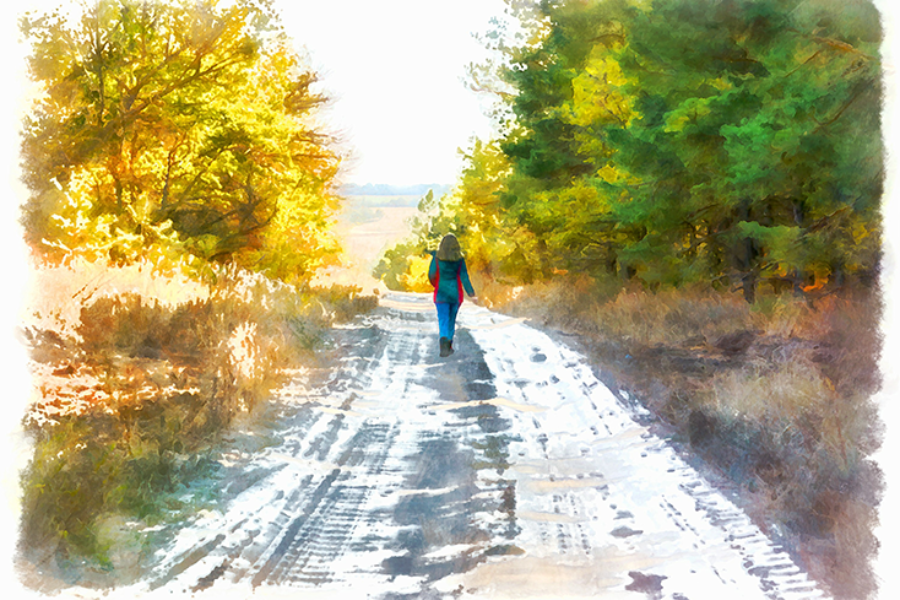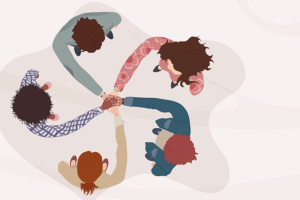By Katy Parker
Last summer, I completed a 10-mile sponsored walk to raise money for the hospital that cared for me after my accident. By the end of the day, I realized I’d walked almost 16 miles.
It was a remarkable achievement, given that nine months earlier, I couldn’t walk at all. I was crossing the street, a van hit me, and I ended up in the hospital with a fractured back.
A week after the accident, I started experiencing distressing flashbacks. As I looked out of my hospital room window and saw the ambulances and traffic below me, memories of my own trauma resurfaced. After conversations with my care team that reassured me that professional intervention would be the option for me, I was ready to reach out for help. Six weeks later, I was diagnosed with posttraumatic stress disorder (PTSD), a mental health condition that can develop after a traumatic event.
As I embarked on the long road to recovery, walking became the key to my physical and emotional well-being.
Recovery Was Challenging, Both Physically And Mentally
After two days in the hospital, the doctors tried to get me moving. I was thrilled when I took my first few steps. Before my accident, I had been an “outdoorsy” and physically active person, so my limited mobility was an adjustment. During physiotherapy, I practiced walking with a frame and later with crutches.
While the physical recovery was difficult, it served as a reminder about the importance of movement. Walking during my physical therapy sessions helped ease my lower back pain and gave me an activity to focus on during a time of uncertainty.
While I slowly regained movement, I struggled with my mental and emotional recovery. While I was once an avid traveller, I suddenly found myself scared to leave the safety of the hospital ward. But I wanted my life back.
After almost two weeks in the hospital, I returned home, light-headed from my medication. I managed to walk upstairs to my bedroom, but I spent a week there before I was able to walk back down. That’s when I knew I needed to get up and start moving to help my recovery.
Walking Became A Source Of Healing And Joy
After my first short walk around our house, my walks became a regular activity. With my husband as my companion, I walked around slowly, still with crutches — and I started to be more observant. I began noticing my surroundings in a way I never had before. I admired the vibrant flowers and trees as we walked in parks and gardens. Once I no longer needed my crutches, we went for longer walks through the forest or on the beach. These outings gave me chance to truly stop and admire the beauty around me. It helped me to find joy in every day, in the simplest things around me.
A few months into my recovery, I went for a short walk by myself. On my own, I noticed how dependent I had become on my husband since the accident; he had always been there when I needed emotional or physical support during my recovery. While I appreciated his care, I yearned for the independence I lost after my accident. I wanted to be able to trust myself again.
So, I began taking solo walks in which I was fully responsible for my own well-being. This step assisted me in slowly restoring my independence, trust and sense of self.
Walking Has Proven Mental Health Benefits
The mental progress I made during my walks shouldn’t come as a surprise; walking releases endorphins, chemicals in our brain that stimulate relaxation and improve our mood. Additionally, research shows that physical activities can help to reduce the severity of PTSD symptoms. And walking certainly achieves this for me.
While high-intensity physical activities can cause shortness of breath and increased heart rate, which can be difficult for those of us living with PTSD symptoms, walking is an ideal form of movement. It’s exercise that you can tailor to your desired intensity level, whether you want a leisurely stroll or a power walk up a hill. It also promotes mindfulness, particularly if you are walking in nature.
Walking Has Become My Self-Care Practice
Walking helps me be present, to enjoy that moment of my life. As my thoughts start to wander, a sudden tooting of a car horn or the sound of the ambulance siren still triggers me to relive the trauma — but then I look for the beauty around me. I take deep breaths of fresh air and focus on my surroundings. I zero in on things I can see, hear or smell. Walking on the beach, I like to take my shoes off and walk barefoot and feel the sand on my feet. It helps me to intensify my senses and see again how beautiful this world can be. For a few minutes, I can forget about my fear or pain.
Walking has also allowed me to slow my mind and ground myself. It helps me to keep my body, mind and spirit in a healthy balance. During my recovery, in the time of the pandemic, they were often the highlight of my day. Of course, on some days, it can be harder to bring myself to go for a walk, but I know that I’m doing it for my general well-being.
Naturally, I can experience anxiety and remain super vigilant while crossing a road, but now I know how to handle the stress. I still have some way to go to get to where I was before the accident. However, I know that I’m walking in the right direction. After all, difficult roads often lead to beautiful destinations. And I’m already thinking about my next walking challenge.
Katy Parker is a mental health advocate and writer based in the UK. She has worked hard to overcome her trauma, and she writes about her experiences to help others in similar situations. She continues to share her journey on her personal blog.
Source: https://nami.org/Blogs/NAMI-Blog/January-2022/How-Walking-Has-Helped-Me-with-My-PTSD-Recovery




